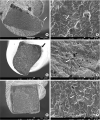1. Peters OA. Current challenges and concepts in the preparation of root canal systems: a review. J Endod. 2004; 30:559–567.

2. Walia HM, Brantley WA, Gerstein H. An initial investigation of the bending and torsional properties of Nitinol root canal files. J Endod. 1988; 14:346–351.

3. Sattapan B, Nervo GJ, Palamara JE, Messer HH. Defects in rotary nickel-titanium files after clinical use. J Endod. 2000; 26:161–165.

4. Cheung GS. Instrument fracture: mechanisms, removal of fragments, and clinical outcomes. Endod Topics. 2007; 16:1–26.

5. Patiño PV, Biedma BM, Liébana CR, Cantatore G, Bahillo JG. The influence of a manual glide path on the separation rate of NiTi rotary instruments. J Endod. 2005; 31:114–116.

6. Ha JH, Park SS. Influence of glide path on the screw-in effect and torque of nickel-titanium rotary files in simulated resin root canals. Restor Dent Endod. 2012; 37:215–219.

7. Gambarini G, Grande NM, Plotino G, Somma F, Garala M, De Luca M, Testarelli L. Fatigue resistance of engine-driven rotary nickel-titanium instruments produced by new manufacturing methods. J Endod. 2008; 34:1003–1005.

11. Al-Sudani D, Grande NM, Plotino G, Pompa G, Di Carlo S, Testarelli L, Gambarini G. Cyclic fatigue of nickel-titanium rotary instruments in a double (S-shaped) simulated curvature. J Endod. 2012; 38:987–989.

12. Neelakantan P, Reddy P, Gutmann JL. Cyclic fatigue of two different single files with varying kinematics in a simulated double-curved canal. J Investig Clin Dent. 2016; 7:272–277.

13. Topçuoğlu HS, Düzgün S, Aktı A, Topçuoğlu G. Laboratory comparison of cyclic fatigue resistance of WaveOne Gold, Reciproc and WaveOne files in canals with a double curvature. Int Endod J. 2017; 50:713–717.

14. Berutti E, Cantatore G, Castellucci A, Chiandussi G, Pera F, Migliaretti G, Pasqualini D. Use of nickel-titanium rotary PathFile to create the glide path: comparison with manual preflaring in simulated root canals. J Endod. 2009; 35:408–412.

15. Pruett JP, Clement DJ, Carnes DL Jr. Cyclic fatigue testing of nickel-titanium endodontic instruments. J Endod. 1997; 23:77–85.

16. Plotino G, Grande NM, Sorci E, Malagnino VA, Somma F. A comparison of cyclic fatigue between used and new Mtwo Ni-Ti rotary instruments. Int Endod J. 2006; 39:716–723.

17. Topçuoğlu HS, Topçuoğlu G, Akti A, Düzgün S.
In vitro comparison of cyclic fatigue resistance of ProTaper Next, HyFlex CM, OneShape, and ProTaper Universal Instruments in a canal with a double curvature. J Endod. 2016; 42:969–971.

18. Versluis A, Kim HC, Lee W, Kim BM, Lee CJ. Flexural stiffness and stresses in nickel-titanium rotary files for various pitch and cross-sectional geometries. J Endod. 2012; 38:1399–1403.

19. Arias A, Perez-Higueras JJ, de la Macorra JC. Influence of clinical usage of GT and GTX files on cyclic fatigue resistance. Int Endod J. 2014; 47:257–263.

20. Frick CP, Ortega AM, Tyber J, Maksound AE, Maier HJ, Liu Y, Gall K. Thermal processing of polycrystalline NiTi shape memory alloys. Mater Sci Eng A Struct Mater. 2005; 405:34–49.

21. Braga LC, Faria Silva AC, Buono VT, de Azevedo Bahia MG. Impact of heat treatments on the fatigue resistance of different rotary nickel-titanium instruments. J Endod. 2014; 40:1494–1497.

22. Capar ID, Kaval ME, Ertas H, Sen BH. Comparison of the cyclic fatigue resistance of 5 different rotary pathfinding instruments made of conventional nickel-titanium wire, M-wire, and controlled memory wire. J Endod. 2015; 41:535–538.

23. Capar ID, Ertas H, Arslan H. Comparison of cyclic fatigue resistance of nickel-titanium coronal flaring instruments. J Endod. 2014; 40:1182–1185.

24. Plotino G, Testarelli L, Al-Sudani D, Pongione G, Grande NM, Gambarini G. Fatigue resistance of rotary instruments manufactured using different nickel-titanium alloys: a comparative study. Odontology. 2014; 102:31–35.

25. Pongione G, Pompa G, Milana V, Di Carlo S, Giansiracusa A, Nicolini E, De Angelis F. Flexibility and resistance to cyclic fatigue of endodontic instruments made with different nickel-titanium alloys: a comparative test. Ann Stomatol (Roma). 2012; 3:119–122.
26. Capar ID, Ertas H, Arslan H. Comparison of cyclic fatigue resistance of novel nickel-titanium rotary instruments. Aust Endod J. 2015; 41:24–28.

27. Uslu G, Özyürek T, İnan U. Comparison of cyclic fatigue resistance of ProGlider and One G glide path files. J Endod. 2016; 42:1555–1558.

28. Johnson E, Lloyd A, Kuttler S, Namerow K. Comparison between a novel nickel-titanium alloy and 508 nitinol on the cyclic fatigue life of ProFile 25/.04 rotary instruments. J Endod. 2008; 34:1406–1409.

29. Shen Y, Hieawy A, Huang X, Wang ZJ, Maezono H, Haapasalo M. Fatigue resistance of a 3-dimensional conforming nickel-titanium rotary instrument in double curvatures. J Endod. 2016; 42:961–964.







